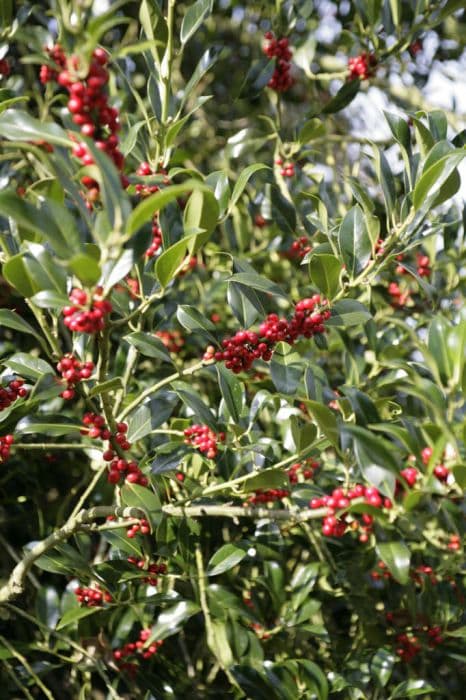English Holly Ilex aquifolium 'Handsworth New Silver' (f/v)

ABOUT
Ilex aquifolium 'Handsworth New Silver', more commonly known as the Silver Variegated English Holly, is a decorative plant with distinctive foliage and berries. This cultivar boasts a striking appearance with its green leaves edged with a creamy-white variegation. The leaves maintain the traditional holly shape, characterized by their spiny-edged and glossy, leathery texture. During seasonal changes, the edges may take on a pinkish hue, adding to the plant’s visual appeal. The Silver Variegated English Holly produces small, white flowers that add a subtle charm to the plant's aesthetic. These are followed by bright red berries that create a classic contrast against the cream and green of the leaves. The presence of these berries also provides a valuable food source for local wildlife, particularly birds, during the colder months. It is important to note that, like other hollies, this plant is dioecious, meaning that to produce berries, a female plant requires a nearby male pollinator of the same species. Overall, Ilex aquifolium 'Handsworth New Silver' presents a lush and vibrant presence in any garden setting, with its variegated foliage lending a unique and ornamental quality that is both eye-catching and elegant.
About this plant
 Names
NamesFamily
Aquifoliaceae
Synonyms
Silver Hedgehog Holly, Handsworth New Silver Holly, Variegated English Holly, Handsworth New Silver Variegated Holly
Common names
Ilex aquifolium 'Handsworth New Silver'
 Toxicity
ToxicityTo humans
The common name for Ilex aquifolium 'Handsworth New Silver' is English Holly. English Holly is considered toxic to humans if ingested. The berries and leaves both contain chemicals that are harmful if consumed. Ingesting parts of the plant may lead to symptoms such as nausea, vomiting, diarrhea, and abdominal pain. In severe cases, it could potentially result in drowsiness, dehydration, and when a large quantity of berries is consumed, it may even be life-threatening due to its cardiotoxicity.
To pets
English Holly is also toxic to pets, including dogs and cats. The toxic principles are similar to those affecting humans, and pets may exhibit symptoms including vomiting, diarrhea, decreased appetite, and excessive drooling. If a pet consumes a large amount of English Holly, there is a risk of more severe reactions such as lethargy, dehydration, and even potentially life-threatening conditions due to the toxin's impact on the heart. Owners should prevent their pets from having access to this plant and seek veterinary care if ingestion is suspected.
 Characteristics
CharacteristicsLife cycle
Perennials
Foliage type
Evergreen
Color of leaves
Variegated
Flower color
White
Height
15 feet (4.57 meters)
Spread
8 feet (2.44 meters)
Plant type
Shrub
Hardiness zones
5
Native area
Europe
Benefits
 General Benefits
General Benefits- Ornamental Appeal: Ilex aquifolium 'Handsworth New Silver' is a holly variety with variegated leaves, offering visual interest throughout the year with its silver-edged foliage.
- Wildlife Habitat: This plant provides shelter and breeding sites for birds and other wildlife.
- Food Source for Wildlife: Produces red berries that are a valuable food source for birds during the winter months.
- Durable: It is hardy and tolerant to a variety of growing conditions, requiring minimal care once established.
- Privacy Screen: Can be used to form dense hedges that offer privacy and reduce noise pollution.
- Seasonal Interest: Provides year-round interest with its evergreen leaves and seasonal berries.
- Drought Resistance: Once established, it can tolerate periods of drought.
- Erosion Control: The root system can help stabilize soil and prevent erosion.
 Medical Properties
Medical Properties- This plant is not used for medical purposes.
 Air-purifying Qualities
Air-purifying QualitiesThis plant is not specifically known for air purifying qualities.
 Other Uses
Other Uses- The variegated leaves of the English holly can be used in the art of marquetry, which involves inlaying pieces of different woods in a veneer to form decorative patterns or pictures.
- English holly wood has a fine grain and is very hard, making it suitable for small carving projects such as chess pieces or intricate jewelry boxes.
- The spiny and dense nature of the English holly makes it a perfect plant for creating a secure and impenetrable hedge to deter burglars or unwelcome wildlife.
- Variegated holly leaves can be sprayed with metallic paint to create unique and festive decorations during the holiday season.
- The branches of English holly can be used in floral arrangements to add structure and a splash of color, especially in winter when flowers are scarce.
- Holly wood's white color and fine texture make it good material for inlays in musical instruments and detailed scroll work.
- As a natural barometer, some people believe that an abundance of holly berries in the fall can indicate a harsh winter ahead.
- The wood of the English holly can be turned on a lathe to create elegant, small turned objects, such as handles for fancy walking sticks or custom pens.
- English holly can be planted as part of a wildlife garden, as its berries provide food for birds and its dense foliage offers shelter and nesting sites.
- The boughs of English holly can be used as natural fencing material around vegetable gardens to help deter animals from eating the crops.
Interesting Facts
 Feng Shui
Feng ShuiThe English Holly is not used in Feng Shui practice.
 Zodiac Sign Compitability
Zodiac Sign CompitabilityThe English Holly is not used in astrology practice.
 Plant Symbolism
Plant Symbolism- Protection: As a cultivar of holly, Handsworth New Silver' carries the symbolism of protection due to its spiny leaves that historically made it a plant to ward off negative energies and malevolent entities.
- Eternal Life: Holly is an evergreen plant, which represents immortality and eternal life, symbolizing the resilience and perpetual nature of life through the changing seasons.
- Good Fortune: In some cultures, holly is seen as a bringer of good luck and is often used in decorations to invite positive energy into the home, especially during winter celebrations.
 Water
WaterThe English Holly 'Handsworth New Silver' prefers consistent moisture but requires well-draining soil to prevent root rot. Water the plant deeply when the top inch of soil feels dry to the touch, which usually translates to once every week during active growth periods. During the hot summer months or in dryer climates, you may need to water twice a week, using about 1-2 gallons per watering, depending on the size and maturity of the plant. In the winter, reduce the frequency to every two to three weeks as the plant's water needs decrease.
 Light
LightEnglish Holly 'Handsworth New Silver' thrives in both full sun and partial shade. It is best positioned in a spot where it receives at least four to six hours of direct sunlight daily but is also protected from the intense afternoon sun which can scorch the leaves in hot climates.
 Temperature
TemperatureEnglish Holly 'Handsworth New Silver' is hardy and can tolerate a range of temperatures, with an ideal growing condition between 50°F and 70°F. It can survive minimum winter temperatures down to about 0°F but may suffer if the temperatures dip below -10°F. These hollies are more temperature flexible than many plants but should be protected from extreme cold with mulch or burlap wraps if necessary.
 Pruning
PruningPrune English Holly 'Handsworth New Silver' to maintain its shape and promote bushy growth. It is best to prune in the late winter or early spring before new growth starts. Prune out any dead, damaged, or diseased branches, and you can also trim it to control size. Occasional thinning of the plant can improve air circulation.
 Cleaning
CleaningAs needed
 Soil
SoilEnglish Holly 'Handsworth New Silver' thrives in well-drained, moderately fertile soil with a slightly acidic to neutral pH, generally around 5.5 to 7.5. For the best soil mix, combine loamy garden soil with peat moss and perlite at equal ratios to improve drainage and aeration while providing adequate nutrients.
 Repotting
RepottingEnglish Holly 'Handsworth New Silver' doesn't require frequent repotting as it is a slow grower; repot every 3 to 5 years during the springtime before new growth starts, or when the plant has outgrown its current container.
 Humidity & Misting
Humidity & MistingEnglish Holly 'Handsworth New Silver' is adaptable to a wide range of humidity levels but prefers moderate ambient humidity. A level of 40-50% is usually sufficient for healthy growth without the need for special humidity interventions.
 Suitable locations
Suitable locationsIndoor
Place in bright, indirect light and maintain cool temps.
Outdoor
Plant in partial shade; shelter from strong winds.
Hardiness zone
5-9 USDA
 Life cycle
Life cycleThe European Holly 'Handsworth New Silver' begins its life cycle with seed germination, occurring in moist, well-drained soil under partial to full shade conditions, often facilitated by pre-treatment to break seed dormancy. From germination, the seedling grows into a juvenile plant, developing distinctive spiny-toothed, variegated leaves and a gradually thickening woody stem over several years. Upon reaching maturity, which can take several years, the holly becomes capable of flowering, usually producing small, white flowers in late spring to early summer, with female plants requiring the proximity of male plants for pollination. After successful pollination, the plant develops red berries in its adult stage, which persists through autumn and winter, serving as a source of food for wildlife and a traditional decorative element. The Holly can have a long lifespan, potentially living for hundreds of years, during which it can undergo cycles of growth, flowering, and fruiting. Periodically, the plant may experience environmental stress or damage, prompting it to enter a state of dormancy or regeneration, ensuring resilience throughout its life cycle.
 Propogation
PropogationPropogation time
Early Spring
The Ilex aquifolium 'Handsworth New Silver', commonly known as the English holly 'Handsworth New Silver', is typically propagated via cuttings. This method is popular due to its effectiveness in producing genetically identical offspring. For the best results, cuttings should be taken from mature plants during the late fall or early winter. Softwood cuttings about 6 to 8 inches long (15 to 20 centimeters) should be cut from the current year's growth. The cut end is often dipped in rooting hormone to enhance root development and then placed in a pot with a mixture of peat and perlite. It's crucial to keep the soil consistently moist and the cuttings in a warm location with indirect light until roots have established, which can take several weeks.









